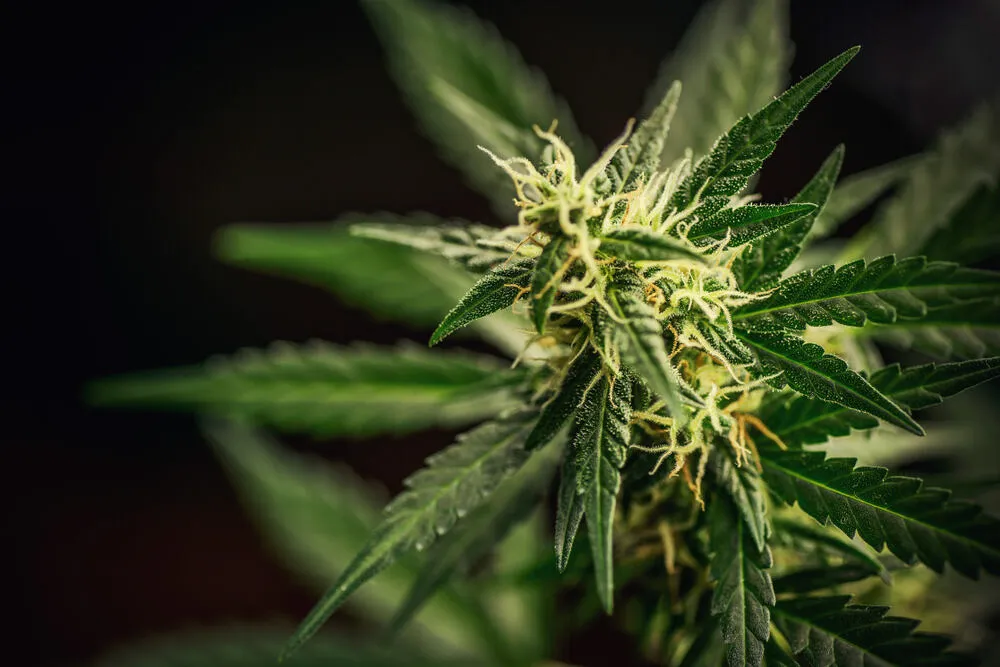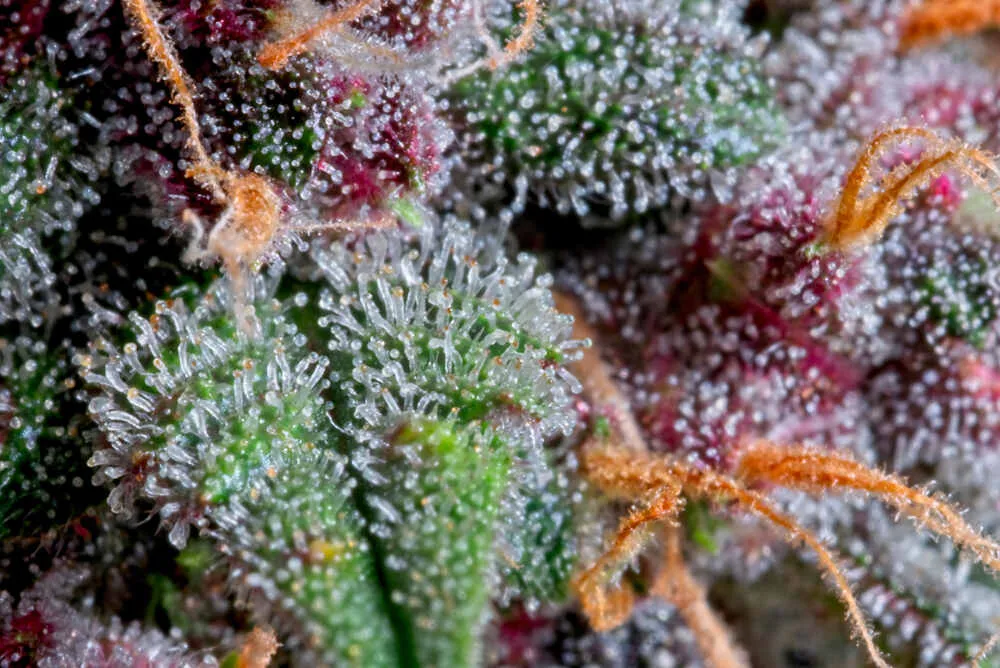What are the orange hairs on weed?

While the bright orange splashes of hair add a certain aesthetic pop to everyone's favorite plant, they're not there just for show. These fiery strands play a crucial role in the plant's reproduction and also provide insights into its maturity and potency.
But that's just scratching the surface. Let's take a quick look at the significance of the orange hairs that grow on weed buds, how they can influence the harvest timing, and what they can tell you about the strain you're smoking.
What are the orange hairs on weed?
The orange hairs you see on buds, scientifically known as 'stigmas' but often referred to as the 'pistils', are thin, hair-like structures that grow on the flowers of female cannabis plants.
What is the difference between stigmas and pistils?
Although the terms are used interchangeably, they actually refer to different parts of the same structure. Stigmas are the actual orange hairs that protrude from the female flowers, while pistils encompass both stigmas and the ovule, which is the plant's reproductive organ.
The orange hairs, or stigmas, play an important role in the plant's reproduction by catching pollen from male plants, which allows for fertilization and seed production. These hairs are usually the first sign most growers look for when trying to determine if a plant has entered the flowering stage, and also to see if a plant is male or female. Most often referred to as "pre-flowers" in the growing community, these early flowers will not develop into full buds but instead remain as they are to catch pollen.
For brevity and simplicity, we'll use the terms 'pistils' or orange hairs for the rest of this write-up, as they are the most commonly used terms in the wider cannabis community.
When pistils first appear, they are typically white or light green in color. As the plant matures through the flower cycle, so do the hairs. They undergo a vibrant transformation, turning into shades of orange or red, sometimes even bright pink. This change in color shows that the plants are maturing and is one of the signals that they are getting close to being ready for harvest.
When do pistils begin to grow on weed?

Pistils start to appear during the very beginning of the flowering stage of growth. For indoor growers working with photoperiodic strains, this happens when the grow lights are switched to a 12/12 cycle, marking the transition from the vegetative to the flowering stage. For plants grown in the great outdoors, this change in growth phase occurs naturally as summer begins to wane and the amount of sunlight decreases with the changing seasons.
The initial signs of this stage in auto-flowering strains often include the emergence of white or light green pistils around the fourth or fifth week, but this timing can vary depending on the strain.
When should pistils turn orange?
The timing of when pistils turn orange can and will vary depending on the individual cannabis strain and the growing conditions. However, pistils generally begin to darken and turn orange during the latter stages of the flowering cycle, often around the 5th week or later.
It's important to note that early darkening is not necessarily a cause for alarm; it could be normal for that specific cultivar. The pistils on autos and fast-flowering plants will mature more quickly than your traditional photoperiod plants, as they are genetically predisposed to flower much earlier in their life cycle. That said, if you notice a premature color change, it can be a sign of pollination or stress. Pollinated flowers usually have hairs that take on a brown appearance near the tip, while the bottom stays a whiter shade.
Understanding Pistil Hair Colour Variations: Decoding Their Significance
The vibrant hues that the pistils display and the color changes they go through play an initial role in determining the maturity and readiness of a cannabis plant for harvest, along with other, more precise methods. Each distinct color represents a unique stage in the plant's life cycle, serving as a basic visual guide for growers.
But what really dictates the color change is the current phytochemical makeup of the hairs.
White/Light Green Pistils
At the beginning of the flowering stage, pistils start to emerge and appear white or light green. This indicates that the plant is still in its early stages of the flower production cycle and nowhere near ready for harvest. These hairs are delicate and have not yet developed into the buds we are looking for as growers, packed full of cannabinoids and terpenes.
Orange
As the plant progresses through its flowering stage, pistils will start to turn orange. This color change signifies that the plant is coming towards its maximum potency, and it's a sign for growers to pay extra attention to their plants as they approach harvest time.
This orange change is caused by the appearance of a group of chemicals known as carotenoids. These chemicals are not only there to give the hairs their vibrant color but are essential in helping the plant attract pollinators and increase seed production.
Red or Pink
Some cannabis strains produce pistils that turn red or pink instead of orange. This is a normal variation and doesn't necessarily indicate a problem with the plant. Like orange pistils, red or pink pistils also suggest that the plant is nearing the end of its growth cycle, but are caused by flavonoids (anthocyanins) rather than carotenoids.
Brown
Brown pistils indicate two different things depending on when they appear. If brown pistils are found early in the flowering stage, and especially if the tips of the hairs turn brown with the base of the hair staying closer to white, it may be a sign that pollination has occurred.
If the orange pistils start to turn a brown hue near the end of the flower cycle (around 7 to 9 weeks after flowering began), it's more likely that the plant is showing you that it has reached full maturity and is ready for harvest. But before you run off to get those trimming scissors ready, you need to check the trichomes for a more accurate picture of harvest readiness.
What is the best way to decide when to harvest?

While pistils can provide some guidance, growers consider trichome color to be the most accurate indicator of when to harvest cannabis for optimal potency. Trichomes are tiny resin glands on the cannabis buds that contain the plant's cannabinoids and terpenes.
By examining the color and clarity of trichomes under a microscope or jeweller's loupe, growers can determine the ideal time for harvest.
So, what color should the trichomes be when you cut your crop?
Trichomes, like pistils, go through a maturing process where they turn from crystal clear to cloudy and finally amber. The ideal time for harvest varies depending on the grower's preference and the desired potency level.
But, as a general rule of thumb, when most of the trichomes have switched from clear to cloudy, with around 30% that have turned amber, it's considered the ideal time to harvest. This will provide a balance between potency and yield.
FAQs
Should all hairs be orange before harvest?
Not necessarily. While the color change of pistils from white to orange or red can indicate maturity, it's not a definitive sign that the plant is ready for harvest. Before investigating further, many growers wait until about 70% of the pistils have changed color. It's also essential to check the trichomes' color and state, as this indicates the plant's harvest readiness more accurately.
Are orange pistils good?
Yes, orange pistils are generally a good sign. They indicate that your cannabis plant is healthy, maturing, and nearing the end of its flowering cycle. However, the exact timing when pistils turn orange can vary depending on the strain and growing conditions.
Why do my buds have so many orange hairs?
Having a ton of orange hairs or pistils on your buds is typically a good sign. It means that the plant is healthy and happy. However, the number of orange hairs does not necessarily correlate with potency, as the cannabinoids and terpenes are produced by the trichomes, not the pistils.
Do pistils turn into buds?
Kind of. They are one important component in the growth of healthy weed flowers and are one part of the female cannabis plant's reproductive system, consisting of a pair of hair-like structures that emerge from each calyx. The bud is the accumulation of these calyxes, along with the trichomes and other parts of the plant.
Do you trim off pistils?
Nope, try to leave as many pistils intact as possible when trimming your harvest. You want to remove the sugar leaves that grow around and directly out of the buds. These leaves contain much higher levels of chlorophyll, making the smoke harsher with less nuance and flavor when compared to properly trimmed buds.
There we go, a full wrap-up of pistils and their significance during the plant's life cycle.
As we've discussed, while pistils can provide some guidance on when to harvest, they are not the most accurate indicator.
Trichomes are what ultimately determine a plant's maturity and potency, so if you are coming to the end of your first weed grow, grab a USB microscope and have a quick peek at the frosty covering to see where your crop is at.
Remember, harvesting at the right time is essential for getting the best results from your cannabis plants. Properly matured buds will provide a more potent high, better flavor, and smoother end result.
-
20+ Years Experience
Over 500K seeds sold worldwide
100K+ Happy Customers -
Germination Guaranteed
Complete satisfaction or we will replace your order -
Dutch and USA Genetics
Master breeders inspiring strains from across the world -
1-5 Day Delivery - Guaranteed
Free Express Shipping to the US, Canada and UK







